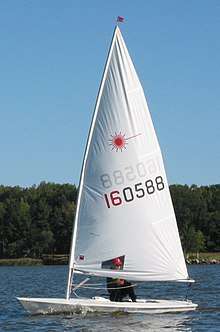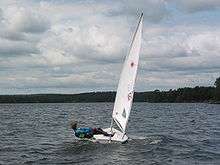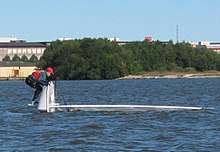Laser (dinghy)
The Laser is a highly popular family of small one-design sailing dinghies using the same common hull and interchangeable rigs with different sail areas. The Laser is designed to be sailed single handed although class rules permit two sailors. Bruce Kirby designed the Laser in 1970 with an emphasis on simplicity and performance.
 Class symbol | |
 Laser Standard | |
| Development | |
|---|---|
| Designer | Bruce Kirby & Ian Bruce |
| Year | 1969 |
| Boat | |
| Crew | 1 |
| Draft | 0.787 m (2 ft 7.0 in) |
| Hull | |
| Hull weight | 58.97 kg (130.0 lb) |
| LOA | 4.2 m (13 ft 9 in) |
| LWL | 3.81 m (12 ft 6 in) |
| Beam | 1.39 m (4 ft 7 in) |
| Sails | |
| Mainsail area | 7.06 m2 (76.0 sq ft) |
| Racing | |
| D-PN | 91.1 |
| RYA PN | 1088 |
| PHRF | 217 |
| Current Olympic equipment | |
The Laser is one of the most popular yacht classes in history. As of 2018, there are more than 215,000 boats worldwide. It is an international class with sailors in 120 countries, and an Olympic class since 1996. A commonly cited reason for its popularity is that it is robust and simple to rig and sail, while also providing very competitive racing due to the very tight class association controls which eliminate differences in hull, sails and equipment.
The Laser hull can be fitted with different interchangeable rigs with varying sail area and similar parts. This allows for a wide range of sailors to sail and compete in a range of wind conditions despite the Laser's small ideal crew weight range for a given rig. Three rigs are recognised by the International Laser Association: original Laser standard with a sail area of 7.06 m²; the Laser Radial with a sail area of 5.76 m²; and the Laser 4.7 with a sail area of 4.7 m².[1][2] Other 'Laser' branded boats with different designs are also available. Examples include the Laser 2 and Laser Pico.
The Laser's hull is made out of Glass Reinforced Plastics. The deck has a foam layer underneath for strength and buoyancy. The daggerboard is removable for storage and transport. The dinghy is manufactured by independent companies under licence in different parts of the world, including Performance Sailcraft Australia (Oceania) and Performance Sailcraft Japan.
History

The boat's history began with a phone call between Canadians Bruce Kirby and Ian Bruce. While discussing the possibility of a car-topped dinghy (a boat small enough to be carried on a roof rack of a typical car) for a line of camping equipment, Bruce Kirby sketched what would be known as "the million dollar doodle". The plans stayed with Kirby until 1970 when One Design and Offshore Yachtsman magazine held a regatta for boats under $1000, called "America's Teacup". After a few sail modifications, the Laser easily won its class.
The prototype was originally named the "Weekender"; the sail held the letters TGIF, a common American abbreviation for "Thank God it's Friday". In December 1970 Dave Balfour, a McGill engineering student, suggested the name Laser and contributed the Laser sail insignia.[3][4] The Laser sailboat was officially unveiled at the New York Boat Show in 1971. The first world championship was held in 1974 in Bermuda. Entrants came from 24 countries, and first place was won by Peter Commette from the United States .
The Laser became a men's Olympic-class boat at the 1996 Summer Olympics in Atlanta, and a special Olympic edition of the boat was released that year in commemoration. A version with a smaller sail, the Laser Radial (see below), was first sailed as a women's Olympic-class boat at the 2008 Summer Olympics. Arguably the greatest champion of the Laser Class is Robert Scheidt (nickname "El Demolidor") from Brazil; he won the world championship eight times and won two gold and one silver Olympic medals.
The Laser is manufactured by different companies in different regions. They include LaserPerformance in Europe and the Americas, Performance Sailcraft Australia in Oceania and Performance Sailcraft Japan in Asia. In 2019, the Laser's status as an Olympic class was reviewed, and retained on the condition that the class complied with the Olympic equipment manufacturers (OEM) policy, allowing any suitably qualified manufacturer to supply boats and class equipment on a Fair, Reasonable and Non-Discriminatory (FRAND) basis. The move would potentially see a significant increase in the number of Laser producers.[5]
Class Association
The Laser is operated under the International Laser Class Association. The Class association operates on four levels: the world level; a regional level based around continents; a district level based around states in the USA and Australia, and nations elsewhere; and at a local fleet level. The association plays a major role in ensuring conformity to Laser class rules worldwide.[2]
Design
As a one-design class of sailboat, all Lasers are built to the same specifications specified in the Laser Construction Manual. The association carries out inspections on manufacturers to ensure that boats are being made to the correct design. These factory specifications are the measurement of boats in a traditional sense. Sailors are prohibited from making any changes to the hull, sail, and spars unless specifically and positively permitted by the rules and are only allowed to use original parts. At regattas, boats are not measured, but rather inspected to ensure conformity with the rules.[2]
The Laser hull is 4.2 metres (13 ft 9½ in) long, with a waterline length of 3.81 m (12.5 ft). The hull weight is 56.7 kg (130 lb), which makes the boat light enough to lift onto a car-top rack.
The various sizes of Laser are all cat-rigged; in they have only a main sail and no head sail. The Laser Standard sail has a sail area of 7.06 m² (76 ft²) and, especially in higher winds (15 knots and over), is most competitive when sailed by a very fit, agile, and muscular person weighing no less than 80 kg (175 lb).
The Laser uses a Portsmouth Yardstick of 1097 for racing involving other classes.[6] The equivalent yardstick in North America is the D-PN, which is 91.1 for a Laser.[7]
21st century rigging update
In recent years, to move the boat with the changing times, the basic sail controls have been upgraded by means of the XD performance kit. This is available from at least two manufacturers, Allen and Harken. Fitting these kits allows the outhaul and cunningham to be adjusted more easily when under sail via cleats fitted to the deck so that the lines are always available to the sailor. These are complemented by extra blocks and a rule-change allowing up to 6:1 outhaul purchase and 10:1 cunningham purchase. The boom vang's positioning is largely unchanged, but features a swivelling cleat and now affords a purchase of up to 15:1 for super vanging in heavy air.
A vendor-supplied clew-cuff, an upgraded traveller and mainsheet boom-blocks with bearings and a new brake design have been approved by class-rules and are available for sale.
Sailing

Laser sailing and racing presents a unique set of physical and skill-based challenges. Fast Laser sailing requires an advanced level of fitness in order to endure the straight-legged hiking and body-torque techniques essential in getting upwind and reaching quickly.
Since 1998 Laser sailing has increased not only to be physical upwind and reaching, but also to include far more demanding sailing and potential speed increases when sailing downwind. Traditionally sailing downwind has been considered processional in dinghy racing, simply being pushed downwind. But Laser sailors, including Ben Ainslie and Robert Scheidt significantly changed the techniques used to race a Laser downwind. The techniques these sailors introduced use a much more dynamic sailing method, concentrating on surfing the waves going downwind. The sailors will weave their way downwind, constantly looking to either side for the next large wave they can "hop" onto and surf downwind. To maximize their speed, boats will often be sailed by the lee, where the air flow over the sail is reversed from its usual direction and thus travels from the lee to the luff of the sail.
This change in technique for downwind racing has changed most dinghy racing to be much more competitive on the downwind legs and resulted in a change of the international course shape from a traditional triangle to a trapezoid giving greater opportunity for increased upwind and straight downwind legs. In addition, downwind Laser sailing can very easily result in a death roll where the boat rocks, flips and capsizes to windward, or the lesser-known big brother of the death roll: the California Roll, where the boat capsizes to windward but the sailor is pushed under the boat before popping up the other side.
Racing
The Laser is raced worldwide from club levels to international and Olympic competitions.
Laser world championships are held in all three rigs, and across junior, open and masters age groups. In total in 2019, the Laser class association awarded 11 world championships. Places for world championships are limited due to high demand and are allotted to countries on the basis of the number of paid association members in each country.[2]
In the Olympics, men race in Laser Standards and women race in Laser Radials.
Identification
A Laser's date and place of manufacture can be determined by looking at the serial number stamped into the transom or under the fairlead on the bow on older hulls. This serial number is unique to the boat and is also the same number that must be displayed on the sail if used for racing. The Laser is unusual in this aspect, since almost every other sailing craft has the numbers assigned by the national organization. This means that the same Laser can be moved between countries without having to change sail numbers. The first commercially sold Laser sailboat had sail number 100: earlier boats were considered "prototypes".
Since Lasers are registered by their hull number, and not their rig, swapping a boat between standard, radial and 4.7 classes is a simple matter of swapping the rig, including sails with a number that corresponds to the hull number.
Rigs using the Laser hull
Lasers can be rigged with a variety of rigs. Three of these rigs, the Standard, Radial and 4.7 are recognised by the International Laser Association, while other rigs have also been developed by third parties and are also available.
| Rig [1] | Sail area (m²) | Weight (kg) | Ideal weight (kg) | UK Portsmouth Yardstick |
|---|---|---|---|---|
| Standard | 7.06 | 70–95 | 80–84 | 1099 |
| Radial | 5.76 | 55–78 | 66–70 | 1145 |
| 4.7 | 4.7 | 40–60 | 51–55 | 1207 |
Laser Standard
The Laser Standard is the original Laser rig. It has been sailed as the Olympic men's singlehanded dinghy since the 1996 Atlanta Olympics.
Laser Radial
In Europe the smaller Radial sail has surpassed the original Laser Standard sail in popularity and replaced the Europe Dinghy as the Women's Singlehanded Dinghy for the 2008 Olympics. The Radial uses the same hull and fittings as the Laser Standard, but has a smaller sail (5.8 m²) than the Standard with a different cut, and has a shorter lower mast section. Optimal weight for this rig is 121 to 159 lb (55 to 72 kg). The Laser Radial rig has a UK Portsmouth Yardstick number of 1139.[6]
Laser 4.7
A smaller sail plan for the Laser was developed about a decade after the Laser Radial. The sail area was reduced by 35% from the Standard (from 7 m² to 4,7 m²) with a shorter, pre-bent bottom mast section, allowing even lighter sailors to sail it. The same formula as the Radial is kept. The hull is the same as the Standard and Radial. Optimal weight for this rig is 110–145 lb (50–65 kg), thus becoming an ideal boat for young sailors moving from the Optimist/RS Tera who are still too light for a normal Laser. The Laser 4.7 rig has a UK Portsmouth Yardstick number of 1200.[6]
Laser M
The Laser M Rig is no longer in production. It was the first attempt at making a smaller rig for smaller sailors. It employed the same lower mast section, but a shorter top section. This variant differed when compared to the other unmodified rigs. This is primarily because the shorter top section didn't allow enough bend to be induced in the mast (as the bottom section is very stiff); this made the boat difficult to sail and de-power especially in heavier winds. This rig is no longer recognized by the Laser Class.
Rooster 8.1
Rooster Sailing, a company based in the UK, designed and created a larger rig for the Laser hull called the Rooster 8.1, specifically designed for heavier sailors. There are two optional mast configurations: either a 3.6 metre one-piece aluminium lower mast section or a fibreglass extender to fit the Laser Standard aluminium lower mast section. The Rooster 8.1 rig is not recognised for racing in events run under the rules of the official International Laser Class Association. At the moment the rig is not available and will not be for the foreseeable future.
The Rooster 8.1 rig has a UK Portsmouth Yardstick number of 1045,[6] it is faster than the Laser Standard rig.
Litigation
Bruce Kirby withdrew the license he had issued to LaserPerformance and later filed a lawsuit against LaserPerformance and Farzad Rastegar[8] on March 4, 2013, claiming non-payment of design royalties.[9] Kirby also claims that the LaserPerformance boats have had issues with quality and parts availability.[10] Kirby required the International Sailing Federation on March 25, 2013, to ask the International Laser Class Association to stop issuing ISAF license plaques to LaserPerformance (Europe) Limited, claiming that LaserPerformance were no longer a licensed builder.[11] Instead ISAF and the ILCA issued a new plaque design,[12] and changed the class rules so that a builder no longer needed to be licensed by Bruce Kirby.[13]
Bruce Kirby Inc. has licensed the sailboat design under the new class name, "Kirby Torch", grandfathering Lasers bearing the "Bruce Kirby" plaque into the new class.[14][15] On August 12, 2016, Bruce Kirby's claims were dismissed. [16][17][18]
In 2019 the ILCA moved against Laser Performance (the UK licensed builder which also owned the trademark on the Laser name) and withdrew its right to build officially measured boats. The ILCA has chosen the new name of "ILCA Dinghy" for the boat. https://sailinganarchy.com/2019/04/25/laser-new-name-for-laser-class-boat/
In 2020, the United States District Court for the District of Connecticut found boat builder Quarter Moon (QMI) and LaserPerformance (Europe) Limited (LPE) liable for a sum of $6,857,736, payable to Kirby.[19][20]
See also
- Laser 2, a double-handed dinghy.
- LaserPerformance, the manufacturer of many dinghies such as Laser Pico, Laser Stratos and the Laser.
- Laser Pico, a small double-handed dinghy designed by Jo Richards in the 1990s mainly for family use
- Laser 4.7
- Laser 28
- Laser Radial
- Laser World Championships
References
- Davidson, Tim (2017). The Laser Book. Leamington Spa: Fenhurst. ISBN 978-1-912177-04-2.
- International Laser Class Association. 2019 Handbook: Constitution and Class Rules (PDF). Retrieved 11 October 2019.
- "Bringing the Laser to Life". www.sailingworld.com. Retrieved 22 March 2018.
- "globeandmail.com: Ian Bruce". v1.theglobeandmail.com. Retrieved 22 March 2018.
- International Laser Class Association (ILCA). "ILCA Now Accepting New Builder Applications". Retrieved 18 October 2019.
- "Portsmouth Number List 2017" (PDF). Royal Yachting Association. Archived from the original (PDF) on 30 June 2017. Retrieved 19 October 2017.
- "Centerboard Classes". US Sailing. Archived from the original on 15 March 2012. Retrieved 31 July 2012.
- "Bruce Kirby, Inc. et al v. LaserPerformance (Europe) Limited et al". RFC Express. Archived from the original on 15 June 2013. Retrieved 9 April 2013.
- "Sail World - The world's largest sailing news network; sail and sailing, cruising, boating news". sail-world.com. Retrieved 22 March 2018.
- "COMMENTARY: It's the boat that matters, not the name >> Scuttlebutt Sailing News". sailingscuttlebutt.com. 24 April 2013. Retrieved 22 March 2018.
- "ISAF Halts Plaques To LaserPerformance". Kirby Torch. Retrieved 9 April 2013.
- "Statement from the International Laser Class Association". International Laser Class Association. Archived from the original on 26 April 2013. Retrieved 16 May 2015.
- "ILCA Class Rules". ILCA. Retrieved April 23, 2013.
-
"History - From Doodle to Kirby Torch". Retrieved April 13, 2017.
Early in 2013, Bruce Kirby Inc executed new builder agreements and rechristened his beloved "car-topper" the KIRBY TORCH.
-
"Why the Kirby Torch?". Retrieved April 13, 2017.
...the Kirby Torch builders agree that all original ISAF-plaqued Lasers that include Bruce Kirby's name are class legal in the Kirby Torch fleet.
- "Case Docket Bruce Kirby, Inc. et al v. LaserPerformance (Europe) Limited et al". Retrieved 16 May 2015.
- Jeffrey Alker Meyer, United States District Judge (12 August 2016). "ORDER REGARDING CROSS-MOTIONS FOR SUMMARY JUDGMENT ON CLAIMS AND COUNTERCLAIMS". New Haven, Connecticut. Retrieved 13 April 2017.
CONCLUSION - For the foregoing reasons, the motion for summary judgment by LPE and QMI (Doc. #186) and the motion for summary judgment by ILCA (Doc. #183) are GRANTED in light of my conclusion that plaintiffs Bruce Kirby and Bruce Kirby, Inc., have no standing to maintain their claims.
- "US District Court Rules Against Kirby". LaserPerformance LLC. 14 December 2016. Retrieved 13 April 2017.
On August 12, 2016 the United States District Court for the District of Connecticut issued its long-awaited order and dismissed complaints and allegations by Bruce Kirby and Bruce Kirby Inc. against LaserPerformance and the International Laser Class Association.
- http://www.canadianyachting.ca/lifestyle/profiles/5455-bruce-kirby-wins-laser-judgment
- https://www.sailingworld.com/story/racing/kirby-triumphs-in-laser-lawsuit/